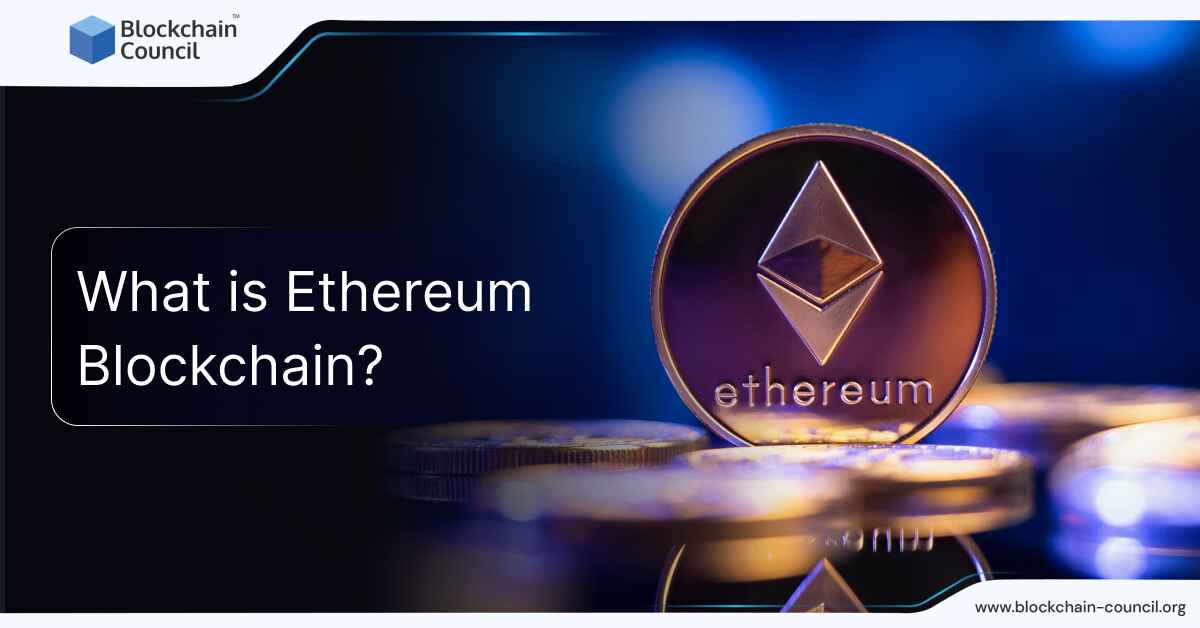- Blockchain Council
- April 17, 2024
Overview
In the realm of blockchain technology, Ethereum stands as a pioneering platform that expands the functionalities of blockchain beyond mere transactions. Launched in 2015 by Vitalik Buterin and a team of developers, Ethereum has transformed the landscape of decentralized application (dApp) ecosystem, providing developers with a platform to create a diverse range of applications spanning from decentralized finance (DeFi) to non-fungible tokens (NFTs). This detailed guide delves into the essentials of the Ethereum blockchain, encompassing its core technology, essential features, applications, and future potential.
Exploring Ethereum Blockchain
Essentially, Ethereum blockchain serves as a decentralized, open-source platform that facilitates the generation and execution of smart contracts and decentralized applications (dApps). Unlike Bitcoin, which primarily functions as a digital currency and payment system, Ethereum’s blockchain is engineered as a programmable platform, enabling developers to construct and deploy smart contracts and dApps.

Essential Elements of Ethereum Blockchain
- Ether (ETH): Ether serves as the inherent cryptocurrency of the Ethereum blockchain, acting as the fuel for executing transactions and smart contracts on the network. Additionally, Ether is utilized as a store of value and a medium of exchange within the Ethereum ecosystem.
- Smart Contracts: These are self-executing contracts with the agreement terms directly encoded into the code. On the Ethereum blockchain, smart contracts are deployed and executed on the Ethereum Virtual Machine (EVM), a decentralized runtime environment. Smart contracts facilitate automated and trustless execution of agreements, eliminating the necessity for intermediaries.
- Ethereum Virtual Machine (EVM): Functioning as a decentralized runtime environment, the Ethereum Virtual Machine (EVM) executes smart contracts on the Ethereum blockchain. The EVM empowers developers to script smart contract code in high-level programming languages such as Solidity, which is then compiled into bytecode and deployed on the blockchain.
- Gas: Gas serves as the unit for measuring the computational work needed to execute transactions and smart contracts on the Ethereum blockchain. Users are required to pay a specific amount of gas to miners as a transaction fee to prioritize their transactions on the network. Gas fees are denominated in ether and fluctuate based on the complexity and computational resources needed for the transaction or smart contract execution.
Applications of Ethereum Blockchain
- Decentralized Finance (DeFi): Ethereum has emerged as the primary platform for decentralized finance (DeFi) applications, offering a broad array of financial services and products without the involvement of traditional intermediaries. These encompass decentralized exchanges (DEXs), lending and borrowing protocols, liquidity pools, derivatives, and yield farming platforms.
- Non-Fungible Tokens (NFTs): Ethereum has become the preferred platform for generating and trading non-fungible tokens (NFTs), representing unique digital assets like digital art, collectibles, virtual real estate, and in-game items. NFTs leverage Ethereum’s smart contract functionality to ensure the authenticity, ownership, and scarcity of digital assets.
- Decentralized Autonomous Organizations (DAOs): Ethereum facilitates the establishment and operation of decentralized autonomous organizations (DAOs), which are organizations governed by smart contracts and managed by their members without centralized authority. DAOs utilize Ethereum’s smart contract capabilities to automate decision-making, voting, fund management, and governance processes.
Challenges and Constraints
Despite its groundbreaking advancements, Ethereum encounters several challenges and limitations:
- Scalability: Ethereum’s existing architecture confronts scalability issues, especially during periods of heightened network congestion. The constrained throughput of the Ethereum blockchain leads to delayed transaction times and elevated gas fees, impeding its capacity to support widespread adoption and mainstream utilization.
- Security: While Ethereum’s smart contracts offer unparalleled functionality, they are vulnerable to security flaws and exploits. Past incidents of smart contract bugs and coding errors have resulted in substantial financial losses, underscoring the significance of rigorous auditing and testing procedures.
- Environmental Impact: Similar to Bitcoin, Ethereum relies on a proof-of-work consensus mechanism that consumes a substantial amount of energy. The environmental repercussions of Ethereum’s energy-intensive mining process have sparked concerns regarding its sustainability and carbon footprint.
Future Prospects
Despite these obstacles, the future outlook for Ethereum remains positive. The Ethereum community actively pursues solutions to tackle scalability, security, and sustainability issues. Ethereum 2.0, a significant upgrade to the Ethereum blockchain, aims to transition from proof-of-work to proof-of-stake consensus mechanism, thereby enhancing scalability and reducing energy consumption.
In Conclusion
To conclude, Ethereum blockchain signifies a notable advancement in the domain of blockchain technology, offering developers and users a platform for constructing and deploying decentralized applications and smart contracts. From decentralized finance to non-fungible tokens and decentralized autonomous organizations, Ethereum has unlocked a realm of possibilities for innovation and experimentation. While challenges persist, Ethereum continues to evolve and innovate, paving the path for a more decentralized, transparent, and inclusive future. As we embark on this voyage of exploration and discovery, Ethereum remains at the forefront of the blockchain revolution, empowering individuals and communities to forge a more equitable and decentralized world.

